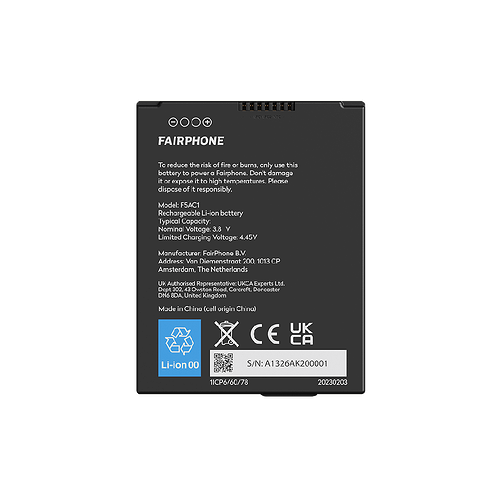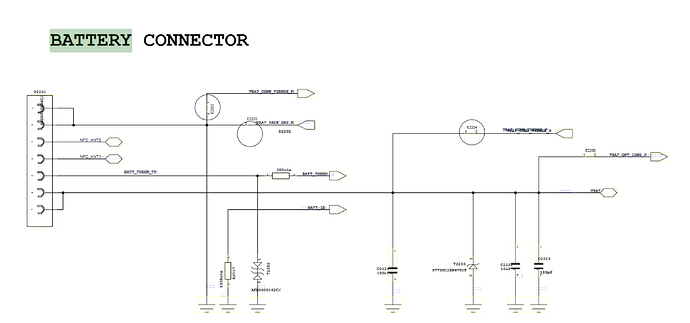I am waiting for spare batteries to be sold at the store.
I want to be able to take with me a spare and just swap it during the day when the battery inside FP5 runs out, just like in the old days.
After that I want to slowly charge the spare at the end of the day with an external charger.
The problem is that there are 2 pins for each polarity in FP5 battery compared to 1 in FP4.
why?
What reliable charger should I get?
I’d measure the voltage on the pins and their combinations. It wouldn’t surprise me if they were just duplicates to distribute the power better when fast-charging. Wasn’t the NFC antenna on the battery, too? That would need some pins, too, I’d assume (but probably not the ones marked with + and -).
For sure one that can hold the very wide battery, that seems to have been an issue with external chargers already. But apart from that I’m not quite sure if the back cover will survive being opened over and over again for too long. For the rare cases when the phone runs out of battery it’s easier to have a power bank or to recharge in advance. For most of us there are sockets around several times per day.
Have you already checked out this thread about external chargers (for FP) in general?
For the rest @Martin_Anderseck pretty much said it all already.
Is there a reason for you not to simply use a power bank? In terms of practical use as well as pricing this is likely the more economical option.
This image is not correct.
Here is an actual photo of the battery.
I mentioned, 2 pins per polarity.
You could measure the resistance between both - and both + in both directions. That should be nearly zero if there is no difference between it.
I’d say the truth is somewhere in the middle. The first picture shows that the two contacts which aren’t marked in the second one are the NFC contacts. It’s not printed on the battery but it is in the plastic housing if you zoom in. The one marked with T in the second picture has the label NTC, so it’s for the temperature. And while I was still too lazy to take apart my phone and check the battery myself I’m pretty confident that plus and minus are there twice each.
Just a graphical summary for our assumption for the pins of the FP5 battery:
⊖ ⊖ O O Ⓣ ⊕ ⊕
M M N1 N2 T + +
Minus, Minus, NFC1, NFC2, Temperature, Plus, Plus
The picture I have sent is a photo I made of my actual FP5 battery with another phone.
Anyway, I emailed support to get a conclusive answer.
I will update this thread with it.
The first photo is a battery from 3th February 2023 and the second battery is from 6th September 2023.
So it looks like they changed the ‘design’ of the battery.
Can you confirmed that the two pluses and two minuses on FP5 battery are connected to the same place?
Is it probably to distribute power?
Is it OK to use external slow charger (about 5W) to charge up to 80% battery?
This is the battery:
And this is the schematic:
Moved your post to your previous post
If those are the official FP5 schematics, then you should be right. They clearly show that both plus and minus connectors are indeed simply split up to two contact areas. This is likely to enable fast charging without damaging the contacts.
As long as your charger is made for Li-Ion batteries and matches the voltages on the battery itself (charging voltage <= 4.45V), you should be good to go.
If your charger has less charging voltage, that should not be a problem with the exception of not being able to charge to 100%. 5W is also totally fine, it’ll just take time as you already noted.
Ya, it exactly the situation.
Although my charger is not branded chinease one.
I should probably look at the thread above better ones.
Thank you for the answer.
I want an external Charger for my FP5-Battery but i have no glue which one I should get / which one is reliable. Are there any ideas / any experience on this issue?
Would be happy about some comments ![]()
Swapping batteries during the day won’t be good for the phone’s battery contacts or the back cover. Fairphone themselves advise to swap the battery every three years, once it weakens. It’s not really meant for constant swapping.
Why not just use a small power bank? I’ve got one that’s smaller than the phone and can do a full recharge twice (using quick charge). It was less than 20 Euros.
@mgkoeln Replacing the battery every 3 years is a long-term recommendation related to the battery, imho. As far as I know there is no comment about how often you can change the battery until the contacts are used up. I searched the forum for battery contacts and found nothing special about FP3-FP5.
If you use a power bank, you use up a power bank consisting of battery, housing and electronics that maybe haven’t got as many fair materials as the FP. The charging connector of the FP gets used more often and if you put the power bank and the phone into a pocket where the power connector gets pressure from the side then the charging module gets used up even more.
The FP2 had no screws to dismantle and that could get a problem since those contacts were not specified for dismantling the phone so often.
Since FP3 screws were used to protect those contacts that cannot withstand the high connection cycles and since the battery contacts are not protected by screws I guess the battery contacts can handle the daily battery changing.
Okay, so both variants have their pros and cons. (To load an extra battery externally, you need some unfair electronics as well). I just wanted to point out, that power banks have gotten smaller and cheaper - and some come with quick charge now. So, this might be an option if you don’t get through the day on a single charge.
I wouldn’t worry as much about the battery contacts as about the back cover. This is clearly not made for constant removal and will start cracking at some point. (I have personal experience with that on the FP4 from having opened and closed it dozens of times at a Fairtrade show.)
While I do sympathize with the argument that a power bank takes more resources than “just” the FP battery, I think this is not entirely correct on closer inspection of the larger picture:
- The bulk of the impact in direct comparison is clearly the battery and not the housing plus additional electronics. The additional impact of those is likely negligible.
- The bulk of the “fair” impact of the FP also is not due to the battery, but the mainboard, so even with a maximally “unfair” power bank, there is still a significant advantage with the FP
- The USB-C connector on the FP4 and up is a pretty sturdy piece in my experience. And even if it breaks after many thousands of cycles, it can be replaced as a single part with very little impact.
- Especially when using a QC-capable power bank, it’s not necessary to keep it connected to your phone while it’s in your pocket: 10-20 minutes of charging should be sufficient for many more hours of use. You can potentially do that while holding it in your hand or while resting somewhere.
- A power bank is much more flexible to use: It can power all kinds of devices, not just the phone. And it can be used for intermittent charging, which the dedicated battery pack cannot do. You have to use it from 100% to empty, then replace it whenever that happens. With a power bank you can recharge from any level to any level whenever convenient.
- (quick) Charging a power bank is so much easier than having to charge the FP battery externally. If you have to charge it internally, that about doubles the amount of swap cycles you’ll have to do, plus the additional hassle and time spent. Charging it externally with a universal charger will only give you about 80%, not 100% battery charge.
Hello, everyone! I’d want a spare battery for my FP5 (I don’t know it this is normal, but it lasts very little to me).
I think this is really useful only if there’s a way to charge both at the same time, one inside the smartphone and the other with an external charger.
As no official external charger seem to exist, I’ve been looking at the so-called “universal” ones.
To try and understand if they could really be compatible, I’ve looked at the contacts in the battery. For some reason, it appears there are two positive poles and two negative poles, one directly beside the other.
Why is that? Can one battery be charged if contact is made on only one pole per polarity?
Lastly, can you tell me if a charger made like this seem a viable option to you?



